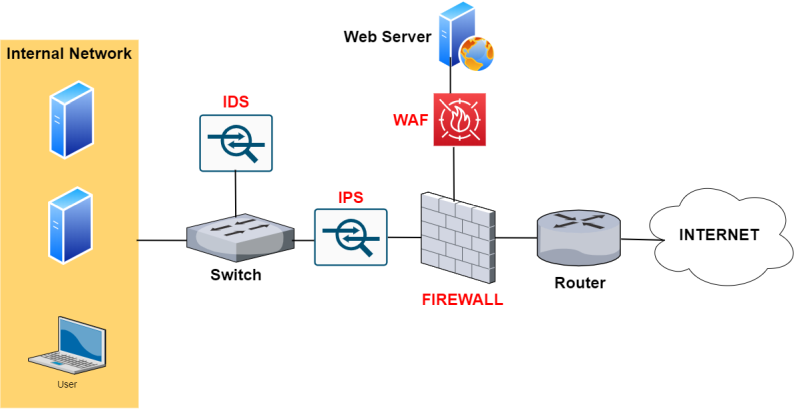The difference between WAF and firewall
This article explains the difference between WAF and firewall.
What is WAF or Web Application Firewall?
A WAF is a firewall for HTTP applications and applies a set of rules to HTTP traffic to protect it from common attacks such as XSS and SQL Injection.
WAF applications
- Firewalls generally monitor network traffic, which means an extra layer of protection that scans all site traffic and defends the network against malicious bots and multi-vector attacks.
- WAFs not only monitor the activities constantly, but also continuously strengthen the weaknesses of the web applications, the WAF scans the vulnerable points and will find and patch these points long before the user notices the weakness in the network.
- Patching is not a permanent or long-term solution, but it gives the user the opportunity to fix the problem and prevent future network intrusions.
Advantages of WAF
Here are some of the benefits that a web firewall has for users and why having this system on your site is a great long-term investment:
- Prevents customer data from being compromised
A web application firewall ensures that customer data is not exposed to any malicious attacks and potential vulnerabilities.
- Wafs of acceptance cause desirability
This firewall ensures that data is handled strictly in accordance with HIPAA and PCI standards to ensure that data is fully organized and in order by blocking opportunities and weaknesses that give hackers the opportunity to attack.
- It saves resources
By automatically running security tests and monitoring traffic, WAF will save significant resources for the user.
- It prevents attacks
A web application firewall will prevent many attacks such as SQL Injection, Cross-Site Scripting (XSS) and Distributed Denial of Service (DDoS) attacks by monitoring traffic, running security tests and patching vulnerabilities.
The difference between WAF and firewall
And now the main topic of this discussion; The difference between WAF and firewall. The most important differences between the two are the following:

-
They work in different ways
As we know, the firewall runs on the network, while the web application firewall is usually installed next to the applications, and these two have completely different functions. The firewall ensures the security of the network traffic of the applications, but the firewall focuses on the network itself and monitors and takes care of the traffic.
- They are located in different places in the network
In general, firewall is placed at the edge of the network, which is a buffer between familiar and trusted networks and unknown networks. While WAF stands before the application and servers, which makes it able to protect the server against any threat. This is the most basic distinction between firewall and WOF.
-
They protect the system against different threats
Generally, standard firewalls are designed for this purpose to allow or deny access to the network, which will prevent unauthorized access to the network. For example, blocking access to pornographic and suspicious content from the school computer can be mentioned as an example of a firewall. But WAF usually focuses on protecting HTTP/HTTPS applications and servers to prevent them from being compromised. such as XSS and DDoS threats.
-
They focus on different layers of the OSI model
The Open Systems Interconnection or OSI layer represents the internal tasks and functions of the standard network, and is actually considered a road map of the network. Firewalls focus on Layer 3 (Network) and Layer 4 (Transport) of the OSI model. Layer 3 is usually about transferring packets between nodes in the network, and layer 4 is about transferring data from a source to a destination host. While the main focus of the web application firewall is on layer 7 (applications), which are closer to the user. Layer 7 is generally the software or interface with which the user interacts with the network.
-
They are different in terms of access control
Another point of difference between WAF and firewall is that the task of firewall of web applications is to monitor the network to prevent attacks on applications, not to limit access. WAF has nothing to do with controlling or restricting access, while access control is the main thing that a firewall does. Firewall settings usually change according to users’ needs and often firewalls are implemented to prevent access to folders, websites, networks – only those with proper credentials will be allowed access.
-
Different algorithms in the difference between WAF and firewall
Since firewall and WAF are different in terms of design and performance, the user might expect that these two have different algorithms, which is completely correct. WEF uses Anomaly Detection Algorithms, Heuristic Algorithms and Signature Based Algorithms. But standard firewalls use proxy algorithms, packet-filtering algorithms, and stateless/stateful inspection algorithms.
-
They implement DDoS protection at different points
Distributed Denial of Service or DDoS attacks are a type of attack that disrupts a network. This attack, as the name suggests, prevents access to the network by dumping an extra load on network access points. Both firewalls offer protection against DDoS attacks, but their protection positions differ. As WAF primarily deals with applications, it provides DDoS protection at the application layer, which is layer 7 of the OSI model. But standard firewalls take care of this against layer 3 and 4 of the network.
-
They have different operating modes
WAF works in two different modes:
- Passive mode : In this mode, the web firewall does not do anything and does not secure the program’s network. The disabled mode should be used only for testing.
- Active Inspection Mode : In this mode, the Wi-Fi constantly scans and protects against any type of threat.
-
The standard firewall has two modes
- Routed Mode : This mode, which is the default firewall, implements static and routing protocols on level 3 and works like a network router.
- Invisible mode ( Transparent Mode ): It works only on layer 2 and because of the connection of interfaces, it provides the possibility of sending invisible data and completely bypasses layer 3.
-
There are different program protection levels
Just as these two firewalls differ in terms of design, function and location, they also differ in terms of the type of application-level protection. The firewall operates at layer 3 and 4 of the model and does not pay much attention to the application layer, which allows it to transfer data between networks. But the main task of WAF is to protect the layer 7 model or the application layer of the network, which means the security of the entire application layer, including applications, software, servers and interfaces that give the user direct access to the network.
-
They have different uses
A WOF is placed in an area connected to the Internet and protects HTTPS/HTTP applications and servers. The purpose is to protect servers and applications. While the firewall means to protect each user as well as the network of people. A firewall is an effective element, but it generally takes care of the basic levels of the network. That’s why WAF is included to further protect the multiple layers of the network. With multiple firewalls, the network will be stronger and more secure.
A note on the difference between WAF and firewall
In this article, we have tried to explain the difference between WAF and firewall. Firewall and Web Application Firewall (WAF) are completely different in terms of functionality and design to make the network infrastructure secure and resilient for users. Knowing these differences will help you design and implement the best scenario for your business.


